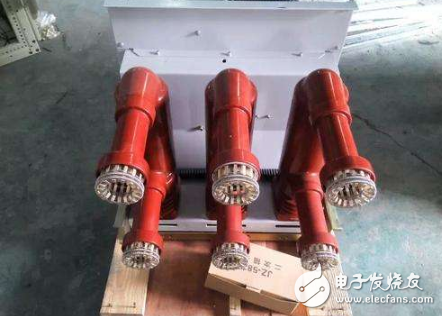This paper begins by examining common faults in the operation of vacuum circuit breakers, conducting a detailed analysis of these issues and offering practical solutions. The goal is to enhance users’ technical knowledge and improve their ability to maintain and troubleshoot these critical electrical devices.
Vacuum circuit breakers are widely used in high-voltage applications due to their numerous advantages, such as being oil-free, having a long electrical and mechanical life, excellent insulation and breaking capacity, compact size, lightweight design, and low maintenance requirements. These features make them highly favored by power system operators, engineers, and technicians. However, early models faced challenges, including unstable quality, excessive contact voltage, and air leakage in some vacuum interrupters. By 1992, during the Tianjin Vacuum Switch Application Promotion Conference, China had made significant progress in vacuum circuit breaker technology, placing it among the world's leading manufacturers. As their use became more widespread, occasional failures began to occur, prompting the need for thorough fault analysis and effective resolution methods.

**First, common operational failures of vacuum circuit breakers**
1. **Circuit breaker refusal to close or open**
This occurs when the closing or opening command is issued, but the breaker fails to perform the action. Despite the electromagnet and spring functioning properly, the arc extinguishing chamber does not close or open correctly.
2. **Unintended tripping**
The circuit breaker trips under normal operating conditions without any external trigger, indicating potential issues with the control circuit or internal components.
3. **Energy storage motor continues to run after full charge**
After the mechanism has stored energy, the motor keeps running instead of stopping, which may point to a faulty travel switch or misalignment in the mechanism.
4. **Increased DC resistance**
Over time, the contact resistance between the arc extinguishing contacts increases, which can lead to overheating and poor performance. This is often caused by wear or improper contact pressure.
5. **Increased closing bounce time**
During closure, the contacts may bounce, and if this time exceeds the standard (≤2ms), it can cause damage to the contacts. This is typically due to spring degradation or mechanical wear.
6. **Surface discharge from CT to bracket**
In the intermediate box, the current transformer may experience surface discharge to the bracket due to an uneven electric field, often caused by damaged insulating coatings.
7. **Failure to disconnect**
After an opening command, the circuit breaker may fail to fully open, which could be due to insufficient vacuum in the arc chamber or internal mechanical failure.
**Second, causes of the failures**
1. **Refusal to close or open**
This is often due to mechanical misalignment or a faulty secondary circuit. For example, a large universal joint head may prevent the mechanism from driving the breaker into the correct position.
2. **Unintended tripping**
A short circuit in the auxiliary switch contacts can cause false tripping, especially if water ingress leads to moisture on the contacts.
3. **Energy storage motor issue**
If the travel switch fails to cut off the power supply after the spring is fully charged, the motor will continue to run, causing unnecessary wear.
4. **High DC resistance**
Contact resistance increases due to wear or improper spring pressure, which affects the circuit’s performance and safety.
5. **Increased closing bounce**
Spring fatigue or increased clearance in the arm and pin can lead to longer bounce times, increasing the risk of contact damage.
6. **CT surface discharge**
Damage to the semiconductor coating on the current transformer during installation can create an uneven electric field, leading to discharges.
7. **Failure to disconnect**
A loss of vacuum in the arc chamber reduces its insulation capability, preventing the breaker from interrupting the current effectively.
**Third, troubleshooting and repair methods**
1. **Refusal to close or open**
Inspect and replace any worn or improperly aligned parts, ensuring all connections are secure and functional.
2. **Unintended tripping**
Check for leaks, apply proper sealing, and ensure the mechanism box is dry. Installing a heating device can also help prevent moisture buildup.
3. **Energy storage motor continues to run**
Adjust the travel switch so that it cuts off the power supply once the spring is fully charged.
4. **Increased DC resistance**
Measure the contact resistance using a DC voltage drop method with a current above 100A. If the resistance is too high, replace the arc chamber.
5. **Increased closing bounce**
Adjust the contact spring pressure, replace worn components, and fine-tune the transmission mechanism to reduce bounce.
6. **CT surface discharge**
Reapply a uniform layer of semiconductor glue to the transformer surface to even out the electric field and prevent discharges.
7. **Failure to disconnect**
Replace the vacuum interrupter if the vacuum level is below the required threshold. Ensure proper installation, alignment, and testing of the new component to restore full functionality.
7 M Light Tower
7 M light tower
A 7 M light tower refers to a light tower that has a height of 7 meters. Light towers are tall structures equipped with lights that are used to provide illumination in various settings, such as construction sites, outdoor events, sports fields, and emergency situations.
A 7 M light tower is typically portable and can be easily transported and set up in different locations. It is designed to provide a wide coverage of light, ensuring visibility in dark or low-light conditions. The lights on the tower can be adjusted to different angles and heights, allowing for flexibility in directing the light where it is needed the most.
These light towers are often powered by generators or can be connected to an external power source. They may also have additional features such as adjustable height, telescopic masts, and remote control operation for convenience and ease of use.
Overall, a 7 M light tower is a versatile lighting solution that can be used in a wide range of applications to ensure safety and visibility in various environments.
7 M Light Tower,Battery Powered Light Tower,Mobile Light Tower Trailer,Diesel Engine Light Towers
Grandwatt Electric Corp. , https://www.grandwattelectric.com
